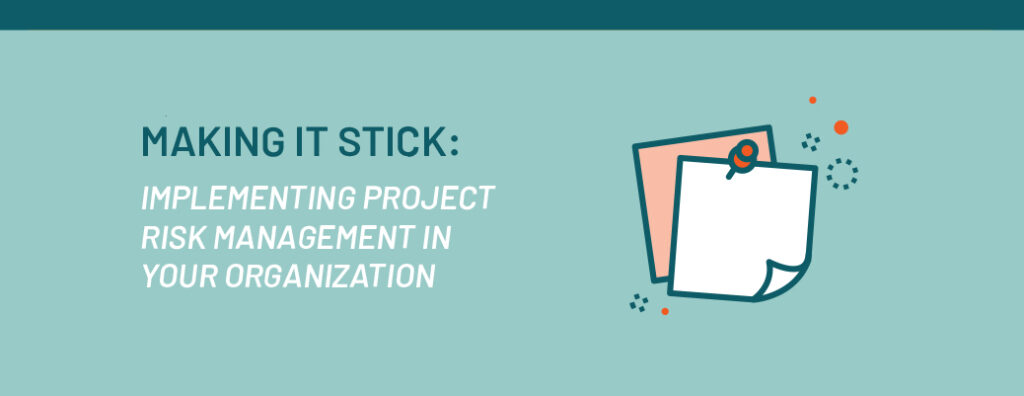
Project risk management (PRM) has for decades been recognized by the U.S. Government Accountability Office (GAO) as a project management best practice. GAO has urged federal agencies to conduct cost and schedule risk analyses to anticipate and quantify risks that can lead to cost increases and schedule delays.
Recently, we have been assisting several of our clients in the adoption of enterprise-wide PRM within their organizations. It is exciting to see these clients drive a culture shift in their project teams with the implementation of PRM fundamentals. The signs of success from these efforts are already evident: a broader team commitment, a cadre of risk management champions, a proactive risk management culture, defined process requirements, and agency-wide training protocols.
Because of the value it can bring to your organization, we encourage everyone to consider implementing an enterprise-wide PRM program while recognizing it can be a significant undertaking.
Eight lessons learned gathered over the course of our advisory services that would serve any organization as you move ahead with PRM:
1. Establish high-level organizational buy-in and find champions
It always starts at the top. The message from leadership that implementing PRM will bring about positive change is important for all in your organization to hear and hear often. Along with that message, it is important to identify strong leaders who will spearhead implementation efforts.
2. Include the entire team along the way
Embarking on a mission to change organizational processes without achieving support from those involved in executing those changes only sets the stage for failure. Seek out guidance from the team along the way. Expend the effort on internally vetting the policies, ensuring buy-in, and gaining appropriate consensus.
3. Don’t rush – winning “hearts and minds” takes time
Recognize that your organization is a big and diverse team: some employees have had long, valuable careers with the organization and some have recently joined with extensive experiences from other prior employers. They each come with varied exposure to PRM. That prior experience may be limited or non-existent. It may even have been negative. Rallying and educating everyone takes time, it takes education, and it takes consistency.
4. Speak plainly
One consistent theme of the “hearts and minds” campaign is establishing consistent and plain-spoken language. Not all employees expected to implement PRM have the same background and there will always be a steady stream of new employees integrating into the process. As such, use terminology that is not too complex to enable everyone to understand the concepts.
5. Communicate that PRM makes business sense
How organizations come to the decision to implement PRM may differ. For some, external forces like a GAO report or audit of past performance may cast light on the need to incorporate PRM to improve project outcomes. For other organizations, an internal examination of a less-than-desired track record of late completion and budget overruns could be the prompt.
Whichever way you arrive at the decision to implement PRM, employees still need to believe that it is a worthwhile undertaking to make it effective. Ultimately, our clients communicated to their teams that the relatively low cost to implement – typically less than 0.5% of total project costs – made it a reasonable choice when compared with the cost impact of realized risks. It was this message – that PRM makes business sense – that was communicated throughout their ranks.
6. Make it fit
For PRM to be widely adopted, it must fit well within an organization’s existing structure and processes. It should become integral with project funding, project management, and other protocols that guide the project life cycle. For example, a quantitative risk assessment at a prescribed stage of design can be used to establish the project budget and duration. It is also important to define at what stage in the project life cycle PRM should be introduced. For example, at one organization, quantitative schedule risk analysis is implemented following contract award but then leads to ongoing qualitative risk management throughout project execution.
7. Demonstrate the second and third order effects
Implementing PRM produces better project outcomes, extending benefits far beyond individual projects – out to overall programs and even entire organizations. As the rate of PRM adoption rises in organizations, so do other positive behaviors impacting project success, producing a continuous improvement feedback loop. For example, from completion of formal risk assessments, risk registers become the basis of lessons learned, prompting changes in inefficient project management processes, changes in ambiguous specification language, and modifications to troublesome design standards, and these, in turn, promote future successful project delivery.
8. Celebrate the new mindset
PRM results in a new mindset that in itself yields benefits:
- Shifting the team’s perspective from a reactive mode to a proactive approach means they anticipate potential negative impacts and plan accordingly instead of diverting attention and resources to recovering from disastrous outcomes.
- Bringing the project team together to identify and plan for risk fosters collaboration, promotes transparency, builds trust, and ultimately can reduce conflict and dispute.
- Third-party risk analysts from outside the project challenge the team’s assumptions and ask the hard questions, prompting the team to dig deeper.
These efforts encourage creativity and a solutions-oriented mindset amongst the team. Project teams who actively engage in the PRM process recognize that some of its greatest benefits emerge from the process itself, perhaps even more than from the cost and time projections it generates.
Implementing PRM in your organization does not need to be difficult. Keeping these eight lessons in mind, the process can be a smooth and collaborative one, and your projects, teams, and overall organization can reap the rewards of project success in short order.
Download a copy of this blog here.






